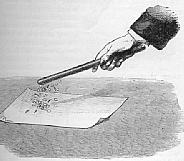
EXPERIMENTS WITH FRICTIONAL
ELECTRICITY
INTRODUCTION:
All the experiments and improvised apparatus
work.
I will give details and then you can discover
for yourself - a more fun way to learn because from your efforts
come results that will stay with you.
As far as possible I will try not to say what
happens - try it and see is the message.
Dimensions of apparatus given are not critical
and you can also experiment with various materials to find which
work best in your situation.
When an experiment works well on one occasion
and not so well on another you may need to wipe and dry the
apparatus.
SAFETY
The first experiment will be to make the only source of electricity you will need to repeat Gray`s investigations. First used by Hauksbee in 1706 and by Gray to make major discoveries - it is simply a tube and a cloth. This, on occasions, will generate very high voltages but at extremely low current.
Do not try any mains or battery powered high voltage supplies. They pose lethal dangers.
You will lose out on the fun of some original studies only changed in that we use modern materials. What Stephen Gray would have given for modern plastics!!!
fffffffffffffffffffffffffffffffff
Experiment 1 A Simple Electrostatic Generator
Stephen Gray used a cylindrical glass tube three feet five inches long, about one and a quarter inches diameter and one inch bore. This was made by a glassblower who blew, to give the hollow centre, and rolled the molten glass at the same to time to draw it out into a cylinder. The ends were cut off to create a tube.
You can use a plastic tube - mail tube - drainpipe - conduit - sink wastepipe, about 2 feet (60cm) long and about 1 inch (2cm) diameter.
Various pieces of fabric, to rub along the tube, can be tested to find the one which gives most charge.
Okay so now we have the static electricity generator.
Hold one end of the tube in one hand and the piece of fabric - the cloth - in the other hand. Grasp the cloth around the tube and either pull the tube through the cloth or wipe the cloth along the tube. Now hold the cloth well clear of the tube which is now charged with electricity. (So incidentally is the cloth - with opposite polarity charge).
Slowly pass the tube by , but not touching your ear and listen. Hear those noises? They are tiny sparks. Maybe you felt hairs stand up as the tube passed.
If the weather is very dry - after several days of hard frost in these parts - and you let your eyes adjust to the dark you may well see sparks when you rub the tube to charge it with electricity.
EXPERIMENT
2
METHOD A
Gray used leaf brass (metal tinsel). You can
make something similar by cutting up aluminium foil into tiny
pieces. Try, also, small bits of dry paper - those little discs
from a hole punch are great for this experiment.
Place a small pile of foil or paper bits on a
flat, dry surface.
Slowly bring the charged tube close to the pile.

METHOD B
Gray
found a down feather useful.
I tried a small fluffy feather from a pillow.
Charge the tube and bring it close to the
feather.
METHOD C An Electroscope
`A Down Feather being tied to the end of a
fine thread of Raw Silk, and the other end to a small Stick,
which was fixed to a Foot, that it might stand upright on the
Table`. Stephen Gray 1720
Fix one end of a wooden dowel about 9 inches long into a hole drilled in a piece of wood. Make sure that the dowel is a tight fit in the hole. For the first trial a piece of clay or plasticine type stuff can serve to hold the dowel upright on the wood rather than a hole in the base.
Tie one end of a piece of cotton to one end of
the feather. Tie the opposite end to the top of the dowel so that
the feather hangs a few inches above the base.
Charge the tube and bring it near to the feather.
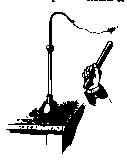
Now you can detect charge. You can try different cloths and different tubes to
decide your best generator.
Charge the tube and bring it near to
the feather. Now, raise the tube to lift the feather
until the cotton thread is vertical above the top of the stick or
dowel. Move the tube about - Levitation!
EXPERIMENT
3 Affecting Smoke
Light an incense (Joss) stick. Bring the
charged tube near to the column of smoke. Try a few inches out
from and below the glowing tip.
(If you feel that these experiments are
embarrassingly simple, bear in mind that this one is the basis of
Electrostatic Precipitation - a major anti-pollution principle.)
EXPERIMENT
4 Water
You need a steady vertical stream of water.
With a tap (faucet) this is easy to get. Otherwise, you need to
knock a small hole in the side of a tin near the bottom, place
the tin on a stand of some sort and fill the tin with water.
Bring the charged tube near to the column of
falling water. Again, a basic principle employed in Electrostatic
Precipitation and in Thunderstorms.
WATER DROP
Tap the point of a flat-headed nail,(head =about 1/8 inch diameter (3mm)), into a piece of wood to give you a vertical metal stand for your water drop.
With care form a drop of water on the flat top.
Try a glass tube to build up the drop OR put a thin stick
horizontally into water - bring it to the nail and carefully tilt
up the stick to let water collect into a drop on the nailhead.
The more globular the shape of the drop the better.
Charge the tube. First move it slowly down above the drop and watch the drop.
Gray speaks of a small `mount of water
rising up`.
Try
the charged tube from underneath and to one side.
Streams of tiny droplets sometimes fly off.
In the dark Gray saw a cone of light rise up as the drop changed shape.
( I tried a version of this experiment but used a Dirod electrostatic generator but hung the water drop from a brass sphere about half inch(1cm) diameter. Here are some results:-
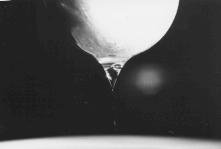
The drop becomes a cone
with a faint corona discharge glow at the point.
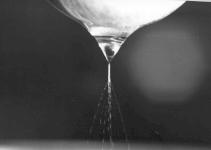
A spray of water droplets issues from the cone shaped drop.
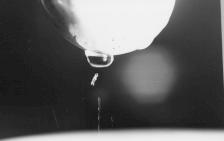
No cone appeared and a single stream broke into pieces.
The implications of this experiment range from
thunderstorms to ink-jet printers.
EXPERIMENT
5 A The Discovery of electrical
conduction. (Effluvium gives way to virtue.)
You need a cork. One from a wine bottle fits
into a piece of plastic conduit.
Rub the tube but not the cork.
According to the effluvium hypothesis - when
you rub the tube you release effluvia (See William Gilbert -
below). This is emitted from the rubbed section only and grabs,
for example, the feather or the pieces of foil or paper, and
attracts them. So, since you did not rub the cork it will not be
emitting an effluvium and will not attract the feather,foil or
paper.
Hold the projecting end of the cork near to the
feather of your electroscope - to bits of paper or foil. Try this
a few times.
You have just repeated the experiment reported by Stephen Gray in 1731. You have discovered that although, according to the effluvium hypothesis, the cork was not charged and therefore should not attract the feather , paper or foil your experiment shows electricity is detected from the cork.
EXPERIMENT
5 B Electrical conduction
Push a piece of stick, dowel if you have it,
about 12 inches (30cm) long, into the cork still in place in the
tube. Hold the tube so that the end of the stick projecting out
of the cork is about a centimetre from the feather of your
electroscope.
Rub the tube with the cloth and watch the
feather.
EXPERIMENT
5 C Electrical conduction 2
Replace the length of dowel or stick with a
piece of metal rod - a bicycle spoke, piece of metal rod, stiff
piece of wire or something similar. Repeat Experiment 5B.
Next, place a pile of foil pieces on the table.
Hold the far end of the rod close to the foil pieces and rub the
rod.
Try it with a pile of paper bits.
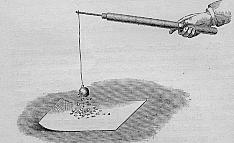
Get a plastic pot, a styrene cup used in some drinks machines for example. Put the cup, upside down, on the table and pile the bits of foil on the base of the cup. Hold the far end of the rod into the bits and rub the tube. Try it with the paper bits.
If you can see copies of Gray`s papers you will feel his excitement of discovery. Papers in his day where not the dull, dry as dust, tedious stuff of today. They are interesting, you may feel quaint, remember this is in the 17th & 18th centuries, but never dull.
It is obvious that there is no effluvia emitted
from either the cork or the wooden stick or the metal rod. He
said that an electric virtue ( virtue meaning a power to produce
an effect) acted from the charged tube through the cork to, and
through, the rod. Read his papers as he tried fishing poles, the
poker, the fire-tongs and coal shovel, a copper kettle and a
silver pot. Boys at Charterhouse School were suspended on silk
cords and they, too, passed the electric virtue to foil pieces,
so did a cockerel and a sirloin of beef.
What you are
observing is electrical conduction. A major discovery that
electricity can be generated at one place and sent - conducted -
to another, to be used.
EXPERIMENT
5 D Electrical conduction 3
Gray tried to make the experiment easier -
rubbing the tube whilst trying to keep the rod near the feather
or pile of foil or paper is irritating to say the least. What was
needed was something flexible. He decided on pack thread. We will
use a length of wire about 1 metre long.
Wrap one end of the wire tightly round the cork
in the end of the plastic tube. The other end of the wire needs
to be just above a pile of foil pieces. Gray supported his wire
on silk threads tied to hang down from a roof beam. You can do
something similar or devise a stand to support the wire.
Rub the tube and watch the far end of the wire.
I did it by raising the charged tube and letting the far end
touch the pile of foil pieces.
With his friends, Granvile Wheler and John
Godfrey, Gray managed to send the effect - the electric virtue -
through 886 feet of pack thread but then the silk supports broken
under the weight.
EXPERIMENT
6 Two Classes of Materials
Gray and his friends reasoned that thin brass
wire was better than silk because it was stronger to support the
weight of the pack thread.
Change the supports of your wire to metal -
thin wires for example - and repeat Experiment 5D.
The `electric virtue` disappears. If you
restore your original set-up of Experiment 5D the effect returns.
Gray realised that some materials e.g. pack thread (wire in your experiment) conduct electricity. These `Non-Electrics` of the effluvia hypothesis we now call CONDUCTORS.
Other materials, such as silk threads and the
plastic of our tube generator, do not conduct electricity. The
`Electrics` of the effluvia hypothesis we now call INSULATORS.
PAUSE TO CONSIDER
These experiments laid the
foundations of power generation at one site and by the means of
conductors and insulators its electrical transmission to other
sites to be used.
At these sites insulators and conductors are
arranged to enable us to use electricity for lighting, heating,
cooking, radio and television, running a car, using this computer
and a whole range of uses from medical electronics to tooth
brushes and pencil erasers - and for ink-jet printing a download
of this page.
EXPERIMENT
7 Lights
If you can work in near total darkness - try
these:-
Watch closely as the cloth is rubbed along the
tube.
Charge the tube - hold it in one hand and move
a finger of your other hand near it and along it.
If it is very dry, a frosty night in Winter,
stand in front of a mirror as you pull off your outer clothes.
The faster, the better. (Remember Rev. Symmer?)
Dufay improved Gray`s set-up by replacing the
silk threads. He simply placed a wire or a metal rod on an
insulating block. You can place a length of metal bar, about 30cm
long and 1cm diameter, on two styrene cups. Charge the tube and
wipe on the bar. Do this several times. Keep a watch on the ends
of the bar for glows or streaks of light.
Bring the knuckle of a finger near one end of
the bar and watch for a spark - you will get a slight shock.
Even in daylight you can see the light of one of those small neon bulbs. Hold one wire in your hand and move the other wire along the charged tube.
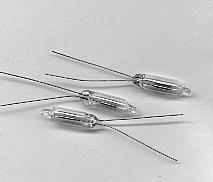
Push one wire into cork in the end of the tube. Grasp the cloth round the tube and pull the cloth towards you and the neon works - a version of our conduction experiments.
If you touch the other wire on metal connected
to the earth the glow is brighter.
You could try the charged metal insulated on
the cups and touch one end of the neon to it.
von Kleist noticed a glow on the end of a metal
rod in a glass jar and carried it from room to room, probably the
first person to discover a portable electric source of light.
In 1735 Gray wrote, `…to increase the Force of this
Electrick Fire, which by several of these Experiments seems to be
of the same Nature with that of Thunder and Lightning.`
It is not too great a claim to say that in
these few experiments you have experienced the discovery of the
fundamental basis for modern electrical technology. They inspired
all the Electricians who came after them and of course gave us so
much in our time.
777777777777777777777777777777777777777
Electrically charging your plastic tube
generator by rubbing it with a woollen cloth is called Frictional
Electrification - i.e. Tribo-electrification.
Many text books regurgitate information to the
effect that dissimilar materials are necessary, plastic and wool
in our case, to generate static electricity. This is not true.
P E
SHAW AND ASYMMETRIC CHARGING
Shaw worked at Nottingham College and found identical materials, when rubbed asymmetrically, will produce electrically charged surfaces. This simply means that if two identical pieces of plastic are rubbed so that a small area of one rubs on a larger area of the other the results are the same as charging a plastic tube with a woollen cloth.
To try Shaw`s experiments you need a sensitive
electrometer. This is something you can aim for in due time.
I repeated Shaw`s experiments using modern
materials, apart from those he used in dust electrification.
For now, I will list his papers if anyone
wishes to read up on the electrical charging of like materials
and, maybe, try them.
Tribo-Electricity and Friction by P E Shaw
& C S Jex Proceedings
of the Royal Society, June 1926
The Electrical Charges from Like Solids by P E Shaw Nature vol. 118, No. 2975,
pages 659-660, November 1926
Electrical Separation Between Identical Solid Surfaces by P E
Shaw Proceedings
of the Physical Society, vol. 39, pages 449-452, 1927
Tribo-Electricity and Friction. Electricity due to Air-Blown
Particles by P E Shaw Proceedings of the Royal Society A, vol. 122, pages
49-58, 1928
77777777777777777777777777777777777777777
FROM EFFLUVIA TO
VIRTUE
William
Gilbert (1540-1603)
In his book, De Magnete, William Gilbert
brought together existing knowledge and results from his own
studies of magnetism and rubbed amber. He called the attractive
properties of rubbed amber electricity.
To concentrate on magnetism he separated off
electrical phenomena.
Earlier investigators had noted that lodestone
will attract lodestone and iron. Rubbed amber will attract a
range of materials. Furthermore, many other substances, when
rubbed, exhibited the amber effect.
Lodestone needed no rubbing in order to
attract.
Magnetic attraction could act through a
barrier. Electrical attraction could not.
Several mechanisms were proposed for amber`s
attractive power. Of interest to Gilbert was the idea that
something was emitted (an effluvium) when amber was rubbed.
He refined earlier ideas into that of an
effluvium - an invisible something which reached out and stuck to
material. A quaint analogy with the horns of a snail which extend
and, when the touch something, rapidly withdraw. So does the
effluvium reach out - withdraw - and bring dust and bits of paper
back to the rubbed surface of the amber.
Or as small sticks placed on water - when close
draw to each other. Likewise do the effluvia of rubbed electrics
cause mutual attraction.
Gilbert denied repulsion as an electrical
effect.
He called things which exhibit electricity -
Electrics. He found many such materials and all had to be rubbed
to attract.
Materials which, when rubbed, do not
electrically attract - he called anelectrics or Non-Electrics.
Metals, for example, he regarded as non-electrics because they
could not be electrically charged by rubbing.
Among Electrics, soft materials needed a light
rubbing to release the effluvium. Hard materials, such as quartz,
needed hard rubbing and were difficult to charge.
Investigators following on from Gilbert began a
long list of Electrics.
7777777777777777777777777777777777777
Stephen
Gray (1666-15th February 1736)
Stephen Gray was born in Canterbury, Kent,
England and baptised on December 26th 1666. His family
were carpenters and dyers and, like most working people, were
keen on education. In his writing, Gray has the confidence of a
self-taught man. His friendship with John Flamsteed (of Denby,
Derbyshire - the first Astronomer Royal) most likely fired his
interests in astronomy.
In a letter, of May 12th 1697, Gray
informed readers of the Philosophical Transactions of the Royal
Society of his use of water lenses and described a `Natural
reflecting Microscope`.
More papers followed on:- Microscopy, Concave
specula, An accurate way to read height of mercury in a
barometer, Haloes and the Sun, Fossils in Reculver Cliff,
Sunspots, Solar Eclipse May 12th 1706.
His electrical interests first appear in a
letter of 1708 to Hans Sloane, in which he described the use of
down feathers to detect electricity. He is obviously fascinated
by lights produced by rubbing a glass tube to charge it and
realises electricity and the lights are related. The idea of an
effluvium released from the tube is giving way in his thoughts to
ideas of a virtue, something akin to gravitational attraction and
electrical conduction.
At a meeting in Somerset House, on April 7th, 1718, Stephen Gray was nominated by the Prince of Wales (later George II) to be admitted as a Pensioner to the Charterhouse in London.

Stephen Gray is
nominated and admitted to London Charterhouse as a Pensioner.
Whilst a Pensioner of the
Charterhouse he carried out, in his sixties, his experiments on
electricity.
Unlike the dry as dust reading of most modern papers, Gray`s are full of enthusiasm.
Philosophical Transactions of the Royal Society.
Vol. 31, pages 105, 107, 1720-21
Vol. 37, pages 18-44, 1731-2
Vol. 37, pages 227-230, 1731-2
Vol. 37, pages 285-291, 1731-2
Vol. 37, pages 397-407, 1731-2
Vol. 39, pages 17-24, 1735-6
Vol. 39, pages 167-170, 1735-6
Vol. 39, pages 220, 1735-6
Vol. 39, pages 400-403, 1735-6